
Zool: Ninja of the Nth Dimension is a platform game written for the Amiga by Gremlin Graphics and published in 1992. It was marketed as a rival to Sega's Sonic the Hedgehog. Zool was ported to other platforms and followed by Zool 2 in 1993.

Flashback, released as Flashback: The Quest for Identity in the United States, is a 1992 science fiction cinematic platform game developed by Delphine Software of France and published by U.S. Gold in the United States and Europe, and Sunsoft in Japan.
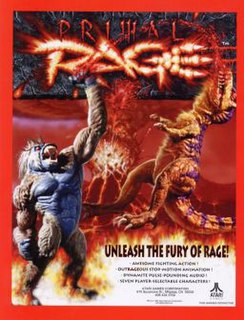
Primal Rage is a fighting game developed and released by Atari Games to arcades in August 1994. The game takes place on a post-apocalyptic version of Earth called "Urth". Players control one of seven large beasts that battle each other to determine the planet's fate. Matches feature many of the conventions of fighting games from the era including special moves and gory finishing maneuvers. Ports were released for home consoles and personal computers. Efforts to perfectly emulate the arcade original have been unsuccessful due to the use of an unusual copy protection method. Toys, comics, a novel and other merchandise tie-ins were produced. The game sold more than 1.5 million copies.

Last Action Hero is a series of action video games based on the 1993 film of the same name. Versions were released for the NES, Super NES, Sega Genesis, Game Boy, Game Gear, and MS-DOS. Versions were also planned for the Sega CD and Master System, but ultimately were not released.

FIFA International Soccer is a 1993 association football video game developed by EA Canada's Extended Play Productions team and published by Electronic Arts. The game was released for the Sega Mega Drive/Genesis console in December 1993 and ported to numerous other systems in 1994. It is the first game in the FIFA series.

Total Carnage is a multidirectional shooter arcade video game originally developed and published by Midway in North America in January 1992. Set in the fictional country of Kookistan during 1999, players assume the role of Captain Carnage and Major Mayhem from the Doomsday Squad in a last-ditch effort to overthrow dictator General Akhboob and his army of mutants from conquering the world, while also rescuing POWs held by his military force.
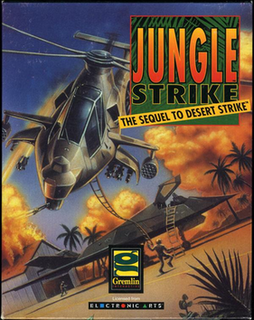
Jungle Strike is a video game developed and published by Electronic Arts in 1993 for the Sega Genesis/Mega Drive. The game was later released on several other consoles such as the Super Nintendo Entertainment System (SNES), and an upgraded version was made for DOS computers. The Amiga conversion was the responsibility of Ocean Software while the SNES and PC DOS versions were that of Gremlin Interactive, and the portable console versions were of Black Pearl Software. It is the direct sequel to Desert Strike and is the second installment in the Strike series. The game is a helicopter-based shoot 'em up, mixing action and strategy. The plot concerns two villains intent on destroying Washington, D.C. The player must use the helicopter and occasionally other vehicles to thwart their plans.

There have been several video games based on the 1991 film Hook. A side-scrolling platform game for the Nintendo Entertainment System (NES) and Game Boy was released in the United States in February 1992. Subsequent side-scrolling platform games were released for the Commodore 64 and the Super Nintendo Entertainment System (SNES), and an arcade beat ‘em up by Irem later in 1992, followed by versions for the Sega CD, Sega Genesis, and Sega's handheld Game Gear console in 1993.
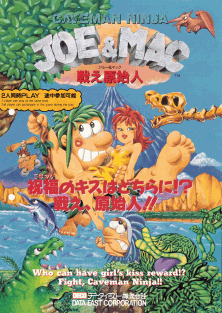
Joe & Mac, also known as Caveman Ninja and Caveman Ninja: Joe & Mac, is a 1991 platform game released for arcades by Data East. It was later adapted for the Super NES, Mega Drive/Genesis, Nintendo Entertainment System, Game Boy, Amiga, Zeebo, Nintendo Switch, and PC.

RoboCop 3 is a video game based on the 1993 film of the same name. Amiga, Atari ST and DOS versions were developed by Digital Image Design beginning in September 1990, and published by Ocean Software in December 1991. The Digital Image Design version includes multiple gameplay styles. During 1992 and 1993, other versions consisting of side-scrolling platform gameplay were released for the Commodore 64, ZX Spectrum, NES, Super NES, Game Gear, Master System, and Sega Genesis.

The Lion King is a platform game based on Disney's 1994 animated film The Lion King. The game was developed by Westwood Studios and published by Virgin Interactive Entertainment for the Super NES and Genesis in 1994, and was ported to MS-DOS, Amiga, Game Gear, Master System, and Nintendo Entertainment System. The Amiga, Master System, and NES versions were only released in the PAL region. It is the final licensed NES game worldwide. The game follows Simba's journey from a young cub to the battle with his uncle Scar as an adult.

Alien 3 is a run and gun video game based on the 1992 film of the same name. The game was released for the Sega Genesis and Amiga in 1992, with additional versions being released in 1993 for the Commodore 64, Game Boy, Game Gear, Nintendo Entertainment System (NES), Super Nintendo Entertainment System (SNES), and Master System.

Brutal: Paws of Fury is a 2D fighting game published by GameTek in 1994. The game features a cast of various anthropomorphic animals as selectable fighters. It also features the ability to learn new attacks and save them via passwords. Originally a Sega CD exclusive, it was later ported to other game consoles.

Super Monaco GP is a Formula One racing simulation video game released by Sega, originally as a Sega X Board arcade game in 1989, followed by ports for multiple video game consoles and home computers in the early 1990s. It is the sequel to the 1979 arcade game Monaco GP. The arcade game consists of one race, the Monaco Grand Prix, but later ports added more courses and game modes based on the 1989 Formula One World Championship.

PGA Tour 96 is a sports video game developed by Hitmen Productions for the PlayStation and MS-DOS versions, Unexpected Development for the Game Boy version, NuFX for the Sega Genesis and 3DO versions, Ceris Software for the Game Gear version, and Polygames for the SNES version and published by EA Sports for PlayStation, MS-DOS, Game Boy, Sega Genesis, 3DO, Game Gear and SNES.
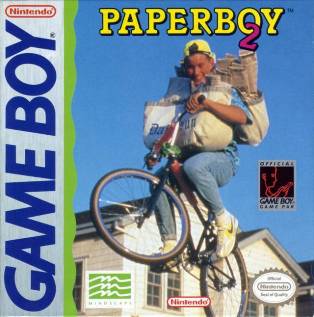
Paperboy 2 is an action video game, the sequel to the arcade video game Paperboy. It was released in 1991–1992 for Amiga, Amstrad CPC, Atari ST, MS-DOS, Game Boy, Game Gear, Genesis, Nintendo Entertainment System, Super NES, and ZX Spectrum. While Paperboy debuted in arcades and was subsequently ported to personal computers and consoles, the sequel was only released for home systems.

Jack Nicklaus' Greatest 18 Holes of Major Championship Golf is a golf-simulation video game developed by Sculptured Software, and published by Accolade beginning in 1988. It was released for Amiga, Amstrad CPC, Apple IIGS, Atari ST, Commodore 64 (C64), MS-DOS, Macintosh, MSX, Nintendo Entertainment System (NES), PC-88, and Sharp X68000.
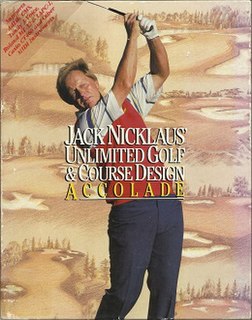
Jack Nicklaus' Unlimited Golf & Course Design is a 1990 golf video game developed by Sculptured Software and published by Accolade for the Amiga and MS-DOS. A Super NES version with the same golf courses, titled Jack Nicklaus Golf, was released in May 1992. It is the second in a series of golf games named after golfer Jack Nicklaus, following Jack Nicklaus' Greatest 18 Holes of Major Championship Golf (1988).
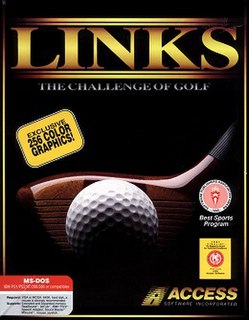
Links: The Challenge of Golf is a golf video game developed by Access Software. It was published for MS-DOS in 1990, followed by the Amiga in 1992. A Sega CD version, developed by Papyrus Design Group, was released in 1994. It is the first game in the Links series, and was followed by Links 386 Pro (1992). A Microsoft Windows version, titled Microsoft Golf, was released in 1992 as the first game in the Microsoft Golf series.
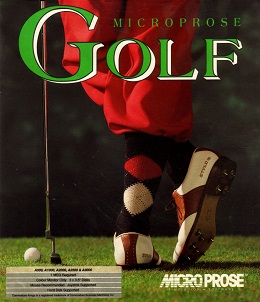
MicroProse Golf is a golf video game developed by The Thought Train and published by MicroProse. It was released in 1991 for Amiga and Atari ST. In 1992, an enhanced MS-DOS version, featuring golf instructor David Leadbetter, was released in the United States as David Leadbetter's Greens and in the United Kingdom as David Leadbetter's Golf. The game's variety was praised, and some critics considered it the best golf game available.




















